Intra-set correlation analysis of medical records of thyroid cancer treated by traditional Chinese medicine Master ZHOU Zhongying
2022-07-02XUZiyunZHUYoLUMingZHOUZhongying
XU Ziyun,ZHU Yo*,LU Ming,b,ZHOU Zhongying*
a. The First Clinical Medical College,Nanjing University of Chinese Medicine,Nanjing,Jiangsu 210023,China
b. Data Mining Center,Medchitec Co.,Ltd.,Nanjing,Jiangsu 210009,China
ABSTRACT Objective Based on intra-set correlation analysis,this paper deconstructs the clinical medical records of traditional Chinese medicine (TCM) Master ZHOU Zhongying in treating thyroid cancer,and analyzes the experience in “mechanism-syndrome-medicine-prescription” for thyroid cancer.Methods Through Medcase data processing platform,based on Frequent Pattern (FP)-Growth enhanced correlation analysis algorithm,the medical records of Professor ZHOU Zhongying for the treatment of thyroid cancer from June 1,2001 to February 28,2015 were analyzed within the set.Results This study involved 43 medical records,43 patients,and 167 visits. After processing intra-set correlations,28 groups of highly correlated symptoms,21 groups of highly correlated tongue images,10 groups of highly correlated pulse conditions,28 groups of highly correlated pathogenesis,34 groups of highly correlated herbs,and 26 groups of highly correlated western medicine diagnosis were selected. Professor ZHOU Zhongying treats thyroid cancer according to syndrome differentiation. Symptoms with more association rules included neck swelling,neck pain,cough,and dry mouth; tongue images with more association rules included dark purple tongue,dark red tongue,and fissured tongue; pulse conditions with more association rules were wiry pulse,thready pulse,small pulse,and slippery pulse; the pathogenesis with more association rules was phlegm and blood stasis,damp-heat accumulation,and impairment of both Qi and Yin; herbs with more association rules were Chaihu (Bupleuri Radix),Zeqi (Sun Euphoribiae Herb),and Tiandong (Asparagi Radix); western medicine diagnosis with more association rules included thyroid cancer,insomnia,and chronic gastritis.Conclusion Thyroid cancer mostly presents as deficiency in origin and excess in manifestations. The basic pathogenesis is phlegm and blood stasis,damp-heat accumulation,and impairment of both Qi and Yin,which are closely related to liver,kidney,and spleen. Professor ZHOU Zhongying adopts both attack and supplement approaches as the general treatment principle,with a strong emphasis on regulating Qi and relieving depression,eliminating phlegm and resolving stagnation,eliminating dampness and turbidity,clearing fire and destroying poison,moistening dryness and softening hard mass,invigorating Qi and nourishing Yin,and paying attention to nourishing liver and kidney,invigorating spleen and stomach,while protecting the heart and lungs.
Keywords Traditional Chinese medicine Master ZHOU Zhongying Thyroid cancer Empirical analysis Data mining Intra-set association Phlegm and blood stasis Damp-heat accumulation Combination of attack and supplement
1 Introduction
Thyroid carcinoma is the most common tumor disease of the endocrine system,and can be divided into papillary carcinoma,follicular carcinoma,and medullary carcinoma,according to the pathology,90% of which are papillary carcinoma and follicular carcinoma[1]. According to the International Agency for Research on Cancer,the incidence of thyroid cancer ranks eleventh in the world,with 586 202 new cases in 2020[2]. It is the fifth most common cancer in women[3]. Ancient physicians thought that emotional factors were the main etiology[4],while modern medicine views that its carcinogenic mechanism is related to mitogen-activated protein kinase (MAPK)pathway,phosphatidylinositol 3-kinase/protein kinase B/mammalian target of rapamycin (PI3K/Akt/mTOR)pathway,or vascular endothelial growth factor (VEGF)[5].In terms of treatment,thyroid cancer is still mainly resected by surgery,but there are many complications after operation[1]. Traditional Chinese medicine (TCM) is effective in relieving postoperative adverse reactions and improving patients’ quality of life. Professor ZHOU Zhongying,a TCM Master,has profound attainments in Qihuang’s skills. His lofty medical ethics and superb medical skills have been widely recognized in the fields of Chinese medicine,both locally and abroad. Having more than 60 years of medical practice,he has accumulated rich and valuable experience in clinical medications,which is worth exploring and studying deeply. Therefore,through the Medcase data processing platform,a Frequent Pattern (FP) tree,constructed based on the FPGrowth enhanced correlation analysis algorithm,was used to make an intra-set correlation analysis on Professor ZHOU Zhongying’s clinical treatment of thyroid cancer,so as to better understand his clinical prescription ideas in the treatment of thyroid cancer.
2 Data and methods
2.1 Data source
The original medical records of thyroid cancer cases treated by Professor ZHOU Zhongying from June 1,2001 to February 28,2015 were collected.
2.2 Diagnostic criteria
(i) Western medicine diagnosis: this study refers to the guidelines for diagnosis and treatment of differentiated thyroid cancer of Chinese Society of Clinical Oncology(CSCO),with pathologic diagnosis as the gold standard.Histopathological examination carried out on the specimens showed clear pathological report of thyroid cancer[1]. (ii) TCM diagnosis: the identified lump,diagnosed as “stone gall”,is described to be hard as stone,uneven,and immovable[4].
2.3 Medical records selection criteria
2.3.1 Inclusion criteria (i) Pathologic diagnosis following surgical operation was clearly “thyroid cancer”.(ii) TCM diagnosis accorded with “stone gall”. (iii) Complete medical records which included western medicine diagnosis,TCM diagnosis,clinical manifestations,tongue images,pulse condition,pathogenesis and/or treatment,medication,etc.
2.3.2 Exclusion criteria (i) Medical records that were repeated,or contained uncertain information,or presented with unclear logical association. (ii) Patients with other diseases such as severe heart,brain,or kidney problems,which affect the diagnosis and treatment of thyroid cancer.
2.4 Data preprocessing
In the research process of text entry and data mining for Professor ZHOU Zhongying’s medical records in the treatment of thyroid cancer,obvious non-research data noises were found due to typographical errors,the use of wrong or different characters in data sources (such as in the records of symptoms,diagnosis,pathogenesis,treatment,herbs,physical and chemical examinations),and the presence of wrong or missing information in records of examination units or doses. Hence,traceability pretreatment was carried out for the purpose of noise reduction and optimization.
2.5 Data standardization
After pretreatment,the whole data of medical record research database were standardized according to the different types of research and analysis algorithms. Standardization of Chinese medicine terms was done according to its subset item groups: item sets of symptoms,diagnosis,and pathogenesis were standardized with reference toInternal Medicine of Traditional Chinese Medicine[6],while herb items were standardized with reference toChinese Materia Medica[7]andChinese Pharmacopoeia(2020 edition)[8]. The process of data standardization was carried out according toStandardization Standard of Data Mining Research on Clinical Medical Records of Traditional Chinese Medicine[9].
2.6 Data analysis
The data analysis of this study was formatted and coded by XMiner V1.0,a subsystem of Medcase Ver5.2,which is an auxiliary platform for inheriting the experience of famous old Chinese medicine practitioners[10]. Based on FPGrowth algorithm for enhanced FP tree,the formatted medical record data were first constructed into an FP tree,then frequent items were recursively mined in the FP tree. The data weight was calculated according to the text characteristics of medical records,and appropriate adjustments were made to the Support and Confidence interval. Data analysis was performed with reference to theOperational Standard for Data Analysis of Data Mining Research on Clinical Medical Records of Traditional Chinese Medicine[11]. The specific algorithm principle is displayed in Figure 1.
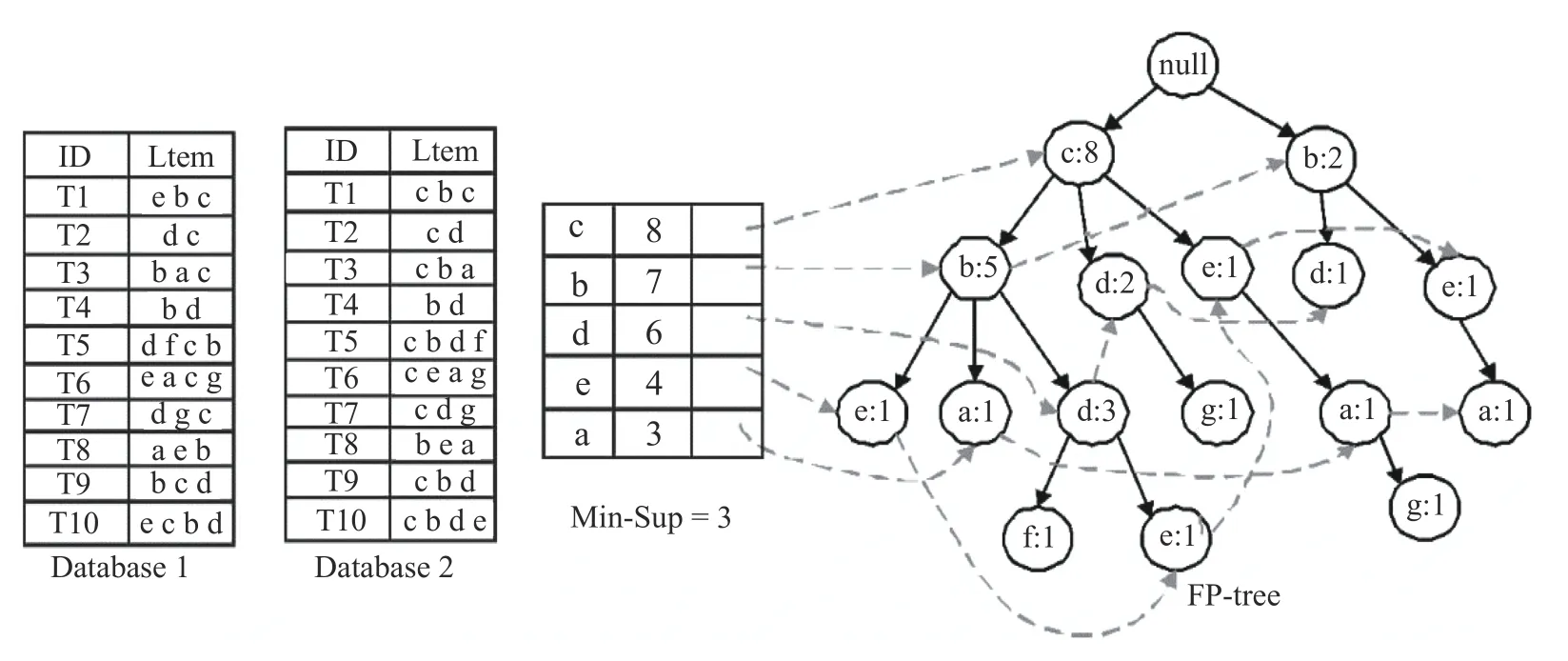
Figure 1 Principle of FP-Growth algorithm [10]
3 Results
3.1 Study baseline distribution
In this study,43 patients with thyroid cancer met the inclusion criteria,with a total of 167 visits. Among them,there were 12 males,accounting for 27.91% of the total number,and 31 females,accounting for 72.09% of the total number (Table 1). The age range found in the study was 28 - 77 years old,and the average age of patients was(49.00 ± 13.66) years old (Table 2). A total of 198 kinds of clinical symptoms and 221 kinds of herbs were involved in this study.

Table 1 Sex distribution of medical records of thyroid cancer treated by Professor ZHOU Zhongying

Table 2 Age distribution of medical records of thyroid cancer treated by Professor ZHOU Zhongying
3.2 Curative effect evaluation of medical records
There were 43 medical cases in this study,among which 18 cases were first-time,single-visit medical records,and 25 cases were medical records of repeated visits; symptoms improvements observed at follow-up visits were recorded in 20 cases,and the rate of improvement for clinical symptoms was 80%. There were 16 long-term medical cases with more than three visits,and the improvement rate of clinical symptoms in all long-term medical cases was 100%.
3.3 Intra-set association of clinical symptoms
Of the association item set in the symptom sets,based on a Support interval greater than 0.040 0 and Confidence interval greater than 0.150 0,symptoms that generated more association rules were neck swelling (n= 4),neck pain (n= 1),cough (n= 6),dry mouth (n= 3),and poor sleep (n= 2) (Table 3 and Figure 2). Symptoms with high correlation to swollen neck were mainly cough,neck pain,dry mouth,and chest tightness; symptom with high correlation to neck pain was swollen neck; symptoms with high correlation to cough were mainly whitesputum,swollen neck,chest tightness,pectoralgia,phlegm,and dry mouth; symptoms with high correlation to dry mouth were mainly poor sleep,swollen neck,and cough; symptoms with high correlation to poor sleepwere the fear of cold and dry mouth. At present,thyroid cancer is mainly treated with thyroidectomy in western medicine,and patients selected for this study were no exception. Thyroidectomy could potentially damage the thyroid gland itself,the adjacent tissues and organs of neck. Therefore,in addition to neck swelling,symptoms of neck pain and cough are also evident. Depending on the different clinical classification and staging of thyroid cancer patients,treatment in western medicine may need to be supplemented by radiotherapy,targeted therapy and chemotherapy. However,these treatment methods attack and damage healthy parts of the body,causing a decrease in the immunity of patients,hence,it is easy to have symptoms of dry mouth,fear of cold,and poor sleep.

Table 3 Association rules of item set in symptom sets(n = 167,Support > 0.040 0,Confidence > 0.150 0)

Figure 2 Structure diagram of association sites in symptom sets (n = 167,Support > 0.040 0,Confidence > 0.150 0)
3.4 Intra-set association of tongue images
Of the association item set in the tongue image sets,based on the Support interval greater than 0.030 0 and Confidence interval greater than 0.100 0,tongue images that generated relatively more association rules were dark purple tongue (n= 4),red tongue (n= 1) ,dark red tongue (n= 4),and fissured tongue (n= 4)(Table 4 and Figure 3). Tongue images with high correlation to dark purple tongue included dark red tongue,yellow,thin,and greasy tongue coating,yellow greasy tongue coating,and fissured tongue; tongue images with high correlation to dark red tongue included greasy tongue coating,yellow greasy tongue coating,fissured tongue,and yellow,thin,and dark purple tongue; tongue images with high correlation to fissured tongue included dark red tongue,yellow,thin,and greasy tongue coating,yellow greasy tongue coating,and dark purple tongue.Dark purple tongue and dark red tongue reflect the pathogenesis of “blood stasis”; yellow greasy tongue coating,and yellow,thin,and greasy tongue coating reflect the pathogenesis of “dampness” and “heat”; fissured tongue reflects the pathogenesis of “Yin deficiency”. To sum up,the tongue images of thyroid cancer patients reflect the pathogenesis of blood stasis,dampness,heat,and Yin deficiency.
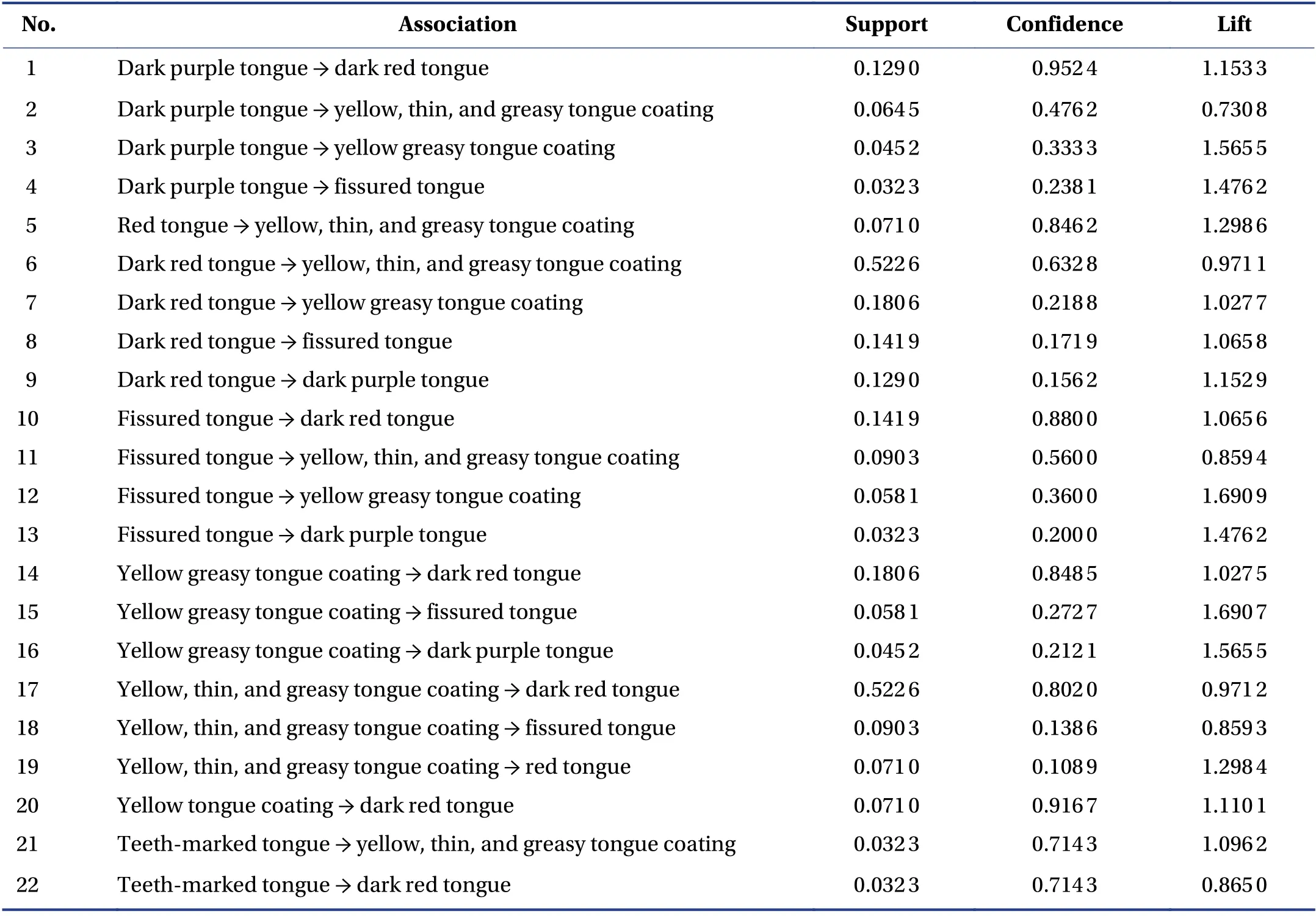
Table 4 Association rules of item set in tongue image sets (n = 167,Support > 0.030 0,Confidence > 0.100 0)
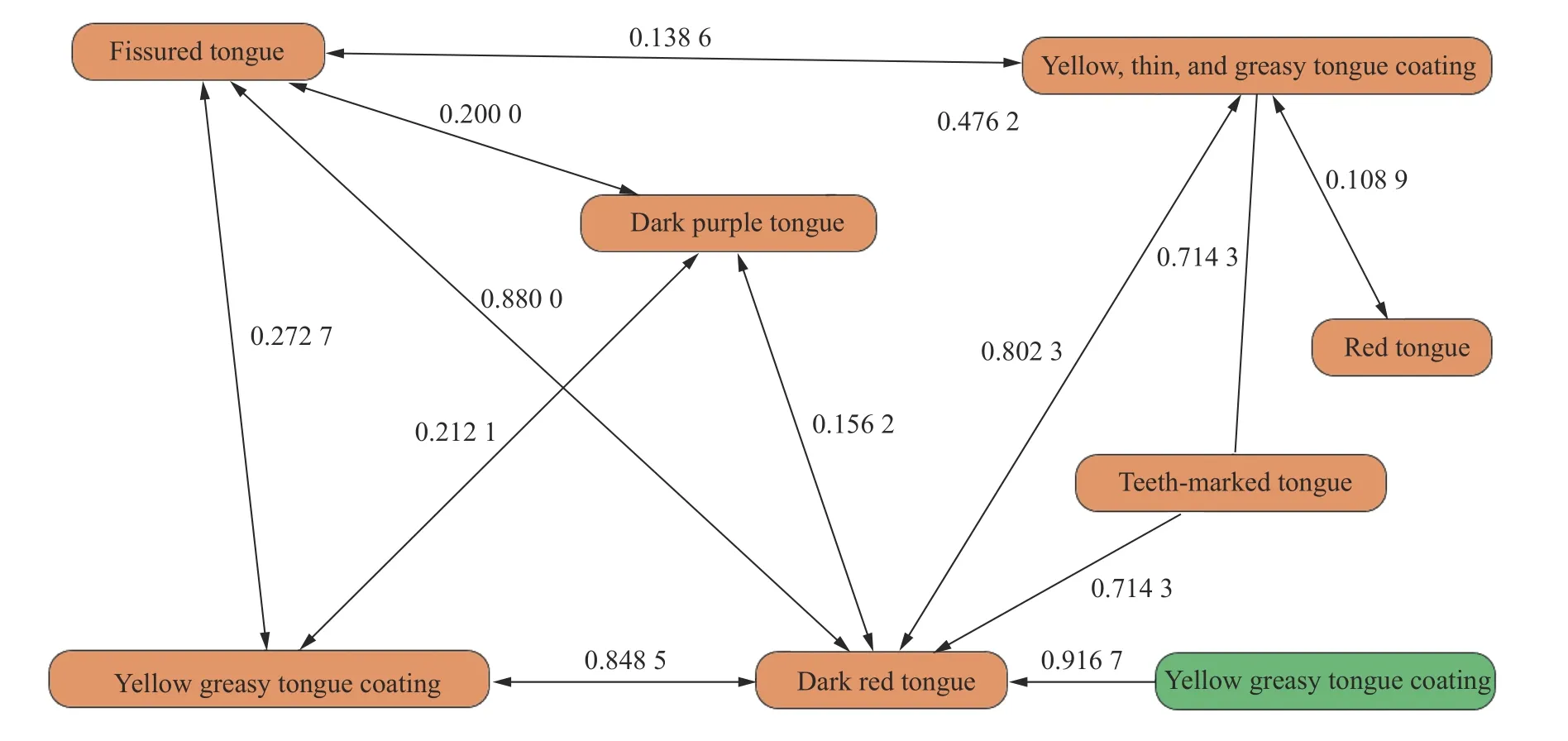
Figure 3 Structure diagram of association sites in tongue image sets (n = 167,Support > 0.030 0,Confidence > 0.100 0)
3.5 Intra-set correlation of pulse conditions
Of the association item set in the pulse condition sets,based on the Support interval greater than 0.030 0 and Confidence interval greater than 0.150 0,pulse conditions that generated relatively more association rules were wiry pulse (n= 3),thready pulse (n= 2),small pulse(n= 2),and slippery pulse (n= 3) (Table 5 and Figure 4).Wiry pulse was highly correlated to slippery pulse,thready pulse,and small pulse; thready pulse was highly correlated to slippery pulse and wiry pulse; small pulse was highly correlated to slippery pulse and wiry pulse;slippery pulse was highly correlated to thready pulse,small pulse,and wiry pulse. Wiry pulse is indicative ofpain,phlegm retention,deficiency-consumption,and decline in stomach Qi; thready pulse is indicative of deficiency in both Qi and blood,virtual strain,and dampness; small pulse could be indicative of either deficiency or excess; slippery pulse is indicative of phlegm retention,food stagnation,and excess heat. As seen,the pulse condition reflects that phlegm-dampness and deficiency are the main pathogenesis of thyroid cancer.
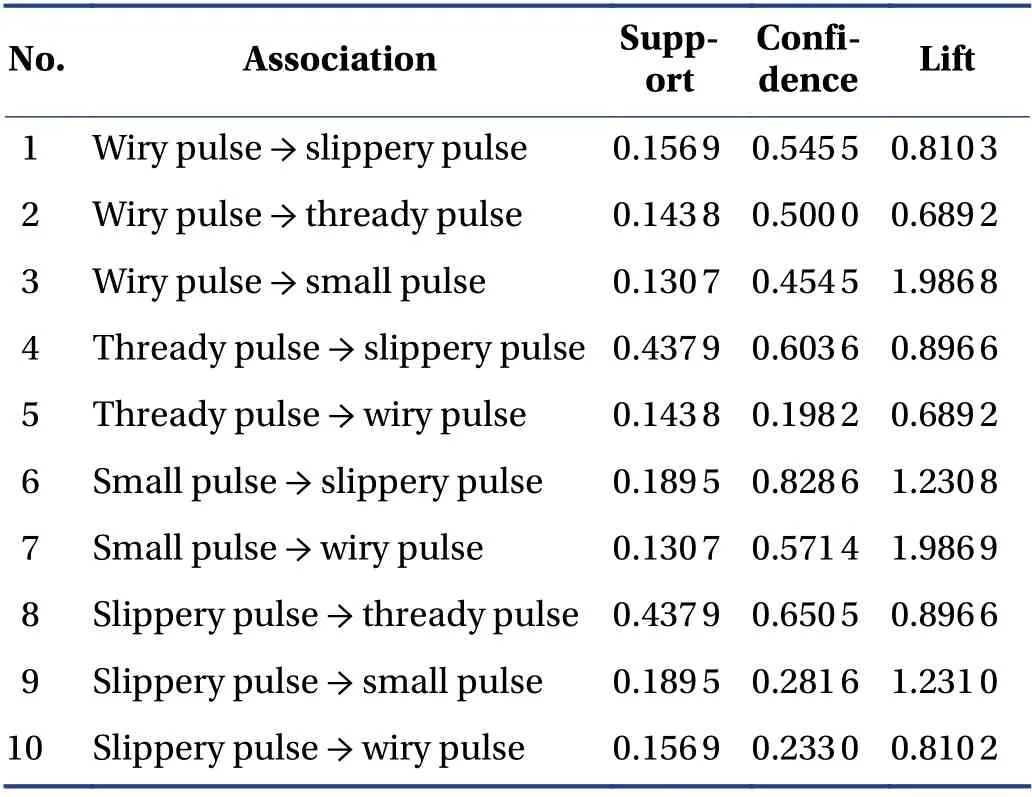
Table 5 Association rules of item set in pulse condition sets (n = 167,Support > 0.030 0,Confidence > 0.150 0)
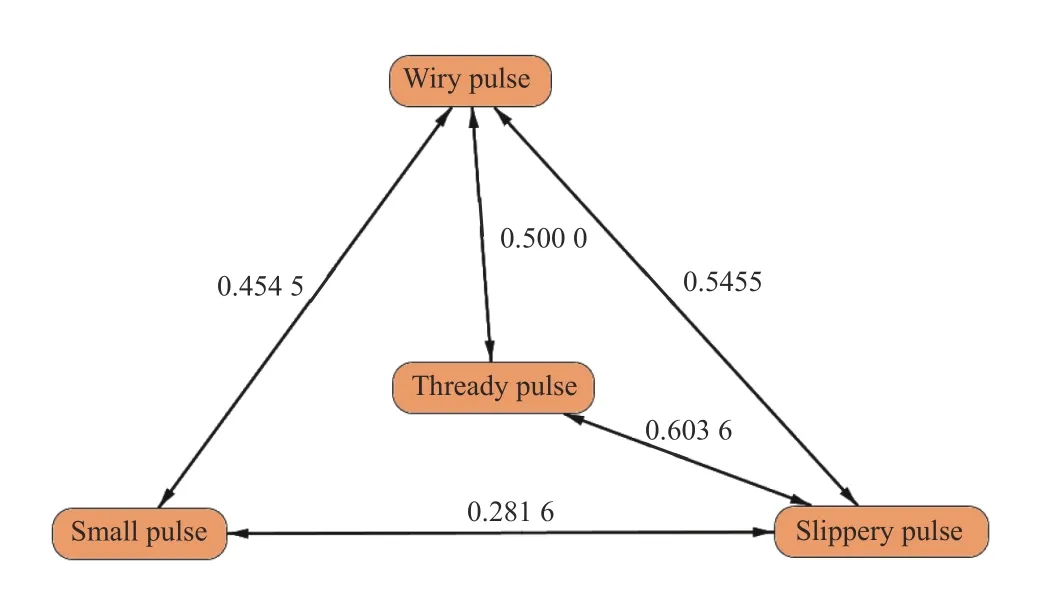
Figure 4 Structure diagram of association sites in pulse sets (n = 167,Support > 0.030 0,Confidence > 0.150 0)
3.6 Intra-set association of pathogenesis
Of the association item set in the pathogenesis sets,based on the Support interval greater than 0.030 0 and Confidence interval greater than 0.140 0,pathogenesis that generated more association rules was phlegm and blood stasis (n= 4),damp-heat accumulation (n= 4),impairment of both Qi and Yin (n= 3),kidney deficiency and liver depression (n= 3),kidney deficiency and liver hyperactivity (n= 2),stagnation of liver Qi (n= 3),liver depression transforming into fire (n= 2),and poor heart Ying circulation (n= 2) (Table 6 and Figure 5). It can be seen that the pathogenesis of thyroid cancer is mostly phlegm and blood stasis,damp-heat accumulation,and impairment of both Qi and Yin. Phlegm and blood stasis binding,and internal accumulation of damp-heat are set as branch,while impairment of both Qi and Yin are considered as the root. Thyroid cancer always belongs to deficiency and excess,and the pathological viscera involved are mainly liver and kidney.

Table 6 Association rules of item set in pathogenesis sets (n = 167,Support > 0.030 0,Confidence > 0.140 0)

Table 6 Continued

Figure 5 Structure diagram of association sites in pathogenesis sets (n = 167,Support > 0.030 0,Confidence > 0.140 0)
3.7 Intra-set association of herbs
Of the association item set in the herb sets,based on the Support interval greater than 0.300 0 and Confidence interval greater than 0.890 0,herbs that generated more association rules were Chaihu (Bupleuri Radix) (n= 1),Zeqi(Sun Euphorbia Herb) (n= 3),Tiandong (Asparagi Radix)(n= 4),Maozhuacao (Ranunculi Ternati Radix) (n= 4),Nanshashen (Adenophorae Radix) (n= 3),Beishashen(Glehniae Radix) (n= 3) (Table 7 and Figure 6). Interestingly,Chaihu (Bupleuri Radix),Zeqi (Sun Euphorbia Herb),Tiandong (Asparagi Radix),Maozhuacao(Ranunculi Ternati Radix),Nanshashen (Adenophorae Radix),Beishashen (Glehniae Radix),Shancigu(Pseudobulbus Pleiones Pseudobulbus),Baihuasheshecao (Hedyotis Diffusa),Biejia (Trionycis Carapax),Zhongjiefeng (Sarcandrae Herba),Xuanshen (Scrophulariae Radix),Xiangfu (Cyperi Rhizoma),Tiannanxing(Arisaematis Rhizoma),Maidong (Ophiopogonis Radix),Jiangcan (Bombyx Batryticatus),Yuzhizi (Akebiae Fructus) are all correlated to Xiakucao (Prunellae Spica),indicating that Xiakucao (Prunellae Spica) plays an important role in Professor ZHOU Zhongying’s treatment of thyroid cancer.

Table 7 Association rules of item set in herb sets (n = 167,Support > 0.300 0,Confidence > 0.890 0)

Table 7 Continued

Figure 6 Structure diagram of association sites in herb sets (n = 167,Support > 0.300 0,Confidence > 0.890 0)
3.8 Intra-set association of western medicine diagnosis
Of the association item set in the western medicine diagnosis sets,based on the Support interval greater than 0.100 0 and Confidence interval greater than 0.100 0,western medicine diagnoses that generated more association rules were thyroid cancer (n= 7),insomnia(n= 4),chronic gastritis (n= 2),lipoma (n= 4),and reflux esophagitis (n= 4) (Table 8 and Figure 7). Chronic gastritis and reflux esophagitis both point towards the spleen and stomach,which shows that thyroid cancer is related to the spleen and stomach.

Table 8 Association rules of item set in western medicine diagnosis sets (n = 167,Support > 0.100 0,Confidence > 0.100 0)
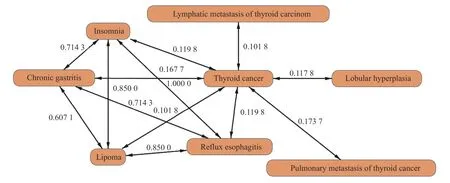
Figure 7 Structure diagram of association sites in western medicine diagnosis sets (n = 167,Support > 0.100 0,Confidence > 0.100 0)
4 Discussion
4.1 Etiology and pathogenesis of thyroid cancer
The number of female patients in this study is more than twice that of male patients,which coincides with the latest epidemiological investigation[12]. In terms of physiological characteristics,the thyroid gland located in the neck is closely related to Ren,liver,and kidney meridians. In TCM,women are born of liver blood; their“Tiangui” (a kind of essence) is formed by the kidneys,and their fetuses are governed by the Ren meridian. As such,the menstruation,pregnancy,and lactation phase of women are intimately associated with Ren meridian,liver,and kidney. In addition,General Records of Holy Universal Relief·Doors to Goiters and Tumors(Sheng Ji Zong Lu·Ying Liu Men,《圣济总录 · 瘿瘤门》)[13]says that “This disease is more commonplace amongst women,because it is the women who experience more melancholy than men”. From the psychological point of view,women worry more easily than men,hence in terms of gender distribution,thyroid cancer is more likely to occur in women. TCM classifies thyroid cancer as “goiter disease”,which is similar to “stone goiter”. Professor ZHOU Zhongying perceives that pathogenesis is an important entry point to understanding diseases. According to the results of data mining,phlegm and blood stasis as well as impairment of both Qi and Yin are the most common pathogenesis of thyroid cancer. Although thyroidectomy has a good curative effect on thyroid cancer,there is a saying in theComplete Book of Ulcer Medicine(Yang Yi Da Quan,《疡医大全》)[14]that goes,“In any sores,fractures,injuries,falls,and internal damage,there will definitely be blood stasis,hence blood stasis is one of the basic pathogenesis of thyroid cancer”.General Records of Holy Universal Relief[13]records that “It is because of the intake of sandy water which enters the pulse together with Qi,and which then stays under the neck that goiter is formed,and also because of inhabiting on the mountains that goiter results”,thus emphasizing that the occurrence of goiter is related to geographical region and diet,and that its development does not occur within a day,but over a longer period of time. In TCM,long-term diseases tend to have the characteristics of phlegm and dampness,hence phlegm is also an important pathogenesis of thyroid cancer.Surgical Authentic·Goiter and Tumor Theory(Wai Ke Zheng Zong·Ying Liu Lun,《外科正宗 ·瘿瘤论》)[15]also states that goiter is caused by blood stasis,turbid Qi,and phlegm stagnation in the five internal organs. Following a long period of time,phlegm and blood stasis combines and stagnates within the body,giving rise to heat. LIU Hejian also pointed out that any disease of dampness pathogenesis mostly arises from heat[16]. Thus,it can be seen that dampness and heat mutually encourage the increase in each other. Phlegm and blood stasis are tangible,while heat is intangible. Intangible heat adheres to the tangible phlegm and blood stasis,and because phlegm and dampness are sticky in nature,it becomes difficult for blood stasis to dissipate quickly; phlegm,blood stasis,and heat stick together,hindering the movement of Qi,blood,and body fluids.Thyroid cancer presents as a syndrome of deficiency in origin and excess in manifestations,in which phlegm,blood stasis,heat,and other excess pathogens stagnate and cause obstruction within the body for a long time,and the body is in a state of weakness with deficiency in Qi,blood,and body fluids. Moreover,most patients with thyroid cancer give priority to western medicine surgery,radiotherapy,and chemotherapy; these treatment methods provide fast and effective results,but they invade too much,and cause evident damage to Qi and Yin,and as such,patients develop dry mouth,poor sleep,and fatigue. From the perspective of visceral syndrome differentiation,thyroid cancer is closely related to liver and kidney. From the perspective of meridian distribution,the liver meridian (also known as Foot Jueyin Meridian)travels along the throat posteriorly,and then enters the nasopharyngeal cavity,the spleen meridian (also known as Foot Taiyin Meridian) goes above the diaphragm,travels alongside the esophagus,connects with the root of the tongue,and spreads over the lower surface of the tongue,and the kidney meridian (also known as Foot Shaoyin Meridian) enters the lungs,goes along the throat,and travels alongside the root of the tongue[17]. As such,the liver,spleen,and kidney meridians all pass near the thyroid gland,and are closely related to it. From the perspective of Professor ZHOU Zhongying’s pathogenesis syndrome differentiation[18],thyroid cancer involves dampness,depression,blood stasis,phlegm,deficiency,and toxin,all of which often occur in tandem to other pathogenesis,such as the co-existence of blood stasis and heat,phlegm and blood stasis,and deficiency and excess.To sum up the above,thyroid cancer is mostly due to deficiency and excess,and its basic pathogenesis is phlegm and blood stasis,and impairment of both Qi and Yin,and is closely related to the liver,spleen,and kidney.
4.2 Prescription and medicine laws
In Professor ZHOU Zhongying’s treatment of thyroid cancer,the commonly used herbs can be grouped into two types: herbs that eliminate pathogenic factors,and herbs that strengthen the body. Taking reference to Professor ZHOU Zhongying’s ten methods of treating tumors[19],herb-pairs eliminating pathogenic factors can be used to regulate Qi and relieve depression [such as Chaihu(Bupleuri Radix) + Xiakucao (Prunellae Spica),Xiangfu(Cyperi Rhizoma) + Xiakucao (Prunellae Spica)],eliminate phlegm and resolve stagnation [Tiannanxing (Arisaematis Rhizoma) + Xiakucao (Prunellae Spica),Shancigu (Pseudobulbus Pleiones Pseudobulbus) + Xiakucao (Prunellae Spica),Shancigu (Pseudobulbus Pleiones Pseudobulbus) + Jiangcan (Bombyx Batryticatus)],eliminate dampness and turbidity [Zeqi (Sun Euphorbia Herb) + Xiakucao (Prunellae Spica),Zeqi (Sun Euphorbia Herb) + Jiangcan (Bombyx Batryticatus),Zeqi(Sun Euphorbia Herb) + Biejia (Trionycis Carapax)],clear fire and destroy poison [Baihuasheshecao (Hedyotis Diffusa) + Xuanshen (Scrophulariae Radix),Baihuasheshecao (Hedyotis Diffusa) + Xiakucao (Prunellae Spica),Baihuasheshecao (Hedyotis Diffusa) + Jiangcan (Bombyx Batryticatus)]; herb-pairs that strengthen the body are mainly used to invigorate Qi and nourish Yin [Nanshashen (Adenophorae Radix) + Xiakucao (Prunellae Spica),Nanshashen (Adenophorae Radix) + Maidong(Ophiopogonis Radix),Nanshashen (Adenophorae Radix) + Beishashen (Glehniae Radix),Beishashen(Glehniae Radix) + Xiakucao (Prunellae Spica),Beishashen (Glehniae Radix) + Maidong (Ophiopogonis Radix),Beishashen (Glehniae Radix) + Jiangcan (Bombyx Batryticatus)]. The results of many experimental studies and clinical studies showed that the Chinese herbal medicines much frequently used by Professor ZHOU Zhongying possess anti-thyroid cancer effect[19-22]. For example,Xiakucao (Prunellae Spica) exhibited multi-component,multi-target,and multi-pathway benefits in the treatment of thyroid cancer,with serine/threonine protein kinase 1 (AKT1),vascular endothelial growth factor A (VEGFA),caspase-3 (CASP3),and MYC being the important therapeutic targets[20]. Maozhuacao (Ranunculi Ternati Radix),through improving the immune function of the body,increases the killing rate of NK cells to tumor cells,and induces the production of tumor necrosis factor to treat immune-mediated tumor diseases[21].JI et al.[22]have shown that Zhimu (Anemarrhe Naerhizoma) has an inhibitory effect on colorectal tumors.The ethanol extract of Yuzhizi (Akebiae Fructus) has antitumor effect on H22cell transplanted tumor in mice[23].
Professor ZHOU Zhongying mainly prefers to use compound prescriptions,and classic prescriptions often involved in his treatment of thyroid cancer are Chaihu Shugan Powder (柴胡疏肝散) and Shashen Maidong Decoction (沙参麦冬汤). Professor ZHOU Zhongying’s prescription also incorporates the consideration of anti-cancer drugs in modern medicine. Professor ZHOU Zhongying uses medical knowledge from the past for the present,and from the West for the East. He knows how to frequently change,and applies both attack and supplement approaches. He emphasizes regulating Qi to relieve depression,eliminating phlegm and resolving stagnation,eliminating dampness and removing turbidity,clearing fire and destroying poison,moistening dryness and softening hard mass,invigorating Qi and nourishing Yin,while paying attention to nourishing the liver and kidney,invigorating the spleen and stomach,and taking into account the heart and lungs.
5 Conclusion
Professor ZHOU Zhongying treats thyroid cancer according to syndrome differentiation. The symptoms with more association rules included neck swelling,neck pain,cough and dry mouth; tongue images with more association rules included dark purple tongue,dark red tongue,and fissured tongue; pulse conditions that produced more association rules were wiry pulse,thready pulse,small pulse,and slippery pulse; the pathogenesis that produced more association rules were phlegm and blood stasis,damp-heat accumulation,and impairment of both Qi and Yin; herbs that produces more association rules were Chaihu (Bupleuri Radix),Zeqi (Sun Euphorbia Herb),and Tiandong (Asparagi Radix); western medicine diagnosis with more association rules included thyroid cancer,insomnia,and chronic gastritis. Thyroid cancer mostly presents with deficiency in origin and excess in manifestations,and its basic pathogenesis is phlegm and blood stasis,damp-heat accumulation,and impairment of Qi and Yin,and is closely related to the liver,kidney,and spleen. Professor ZHOU Zhongying uses both attack and supplement approaches as the general principle,with an emphasis on regulating Qi and relieving depression,eliminating phlegm and resolving stagnation,eliminating dampness and turbidity,clearing fire and destroying poison,moistening dryness and softening hard mass,invigorating Qi and nourishing Yin,while paying attention to nourishing the liver and kidney,invigorating the spleen and stomach,and taking into account the heart and lungs. Through data mining of the medical records by Professor ZHOU Zhongying in the treatment of thyroid cancer,this paper provides reference for the clinical prescription of Chinese medicine in the treatment of thyroid cancer,in terms of providing an in-depth analysis of master-level clinical experience and a summary of thyroid cancer-related knowledge.
Fundings
Six Talent Peak Projects in Jiangsu Province (RJFW-40),Jiangsu Province “333 High-level Talent Training Project”(2018III-0121),Technology Innovation Fund of Science and Technology Enterprises in Jiangsu Province (BC2015 022),Representative Project of Intangible Cultural Heritage in Pukou District,Nanjing (PKIX-4),and The Construction and Application of Thyroid Disease Differentiation and Treatment Rule Mining and Clinical Decision Support System by Traditional Chinese Medicine Master ZHOU Zhongying (012071003583).
Competing interests
The authors declare no conflict of interest.
猜你喜欢
杂志排行
Digital Chinese Medicine的其它文章
- Visualization analysis of the international standard ISO/TC 249 for traditional Chinese medicine
- MEDICLOUD: a holistic study on the digital evolution of medical data
- Ancient and modern medication laws of aromatic Chinese medicines in treating angina pectoris based on data mining
- Traditional Chinese medicine Master XIONG Jibo’s medication experience in treating arthralgia syndrome through data mining
- Screening influencing factors of blood stasis constitution in traditional Chinese medicine
- Mechanisms of Dihuang (Rehmanniae Radix) in treating diabetic nephropathy complicated with depression based on network pharmacology
